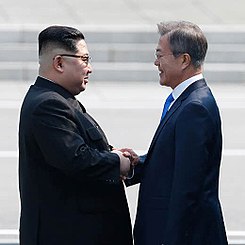Peace on the Peninsula?

Kim Jong-un and Moon Jae-in
May 3, 2018
Up until the last few months, I likely would’ve scoffed at the very idea of reunification—no, successful diplomacy—between the two Koreas. But like most everything we’ve seen in the era of Trump, the recent summit between South Korean Moon Jae-in and Kim Jong-un has left me with my mouth hanging wide open. Before going into the summit, though, it’s important to cover a general history of North Korea’s post-war background with the United States to answer the question of whether this recent meeting is as much of a breakthrough as people are saying. (Spoiler alert, it is.)
To begin, the US-NK relationship has been—to say the least—complicated. The first successful advance in diplomacy would likely be the Agreed Framework, which was signed in October of 1994. The agreement froze nuclear development in North Korea in exchange for light-water reactors that could produce energy (but not weapons fuel) to compensate for the loss of the former. It was also decided that while the reactors were being built, heavy fuel oil would be sent to North Korea. The relationship was strained due to North Korea’s violations of the negotiations and its withdrawal of the NPT (Nuclear Proliferation Treaty), but (surprisingly enough), the United States also failed to follow the agreement through. There are many reasons why it was likely doomed from the start: first, the organization responsible for the reactors’ construction was in severe debt; second, the sitting president at the time, Bill Clinton, had likely overestimated the contribution of US allies while underestimating the cost of the reactors; and third, American hostility towards the DPRK certainly wasn’t getting any lower. However, during the time while the framework was active, it didn’t get better at all. The aforementioned heavy fuel deliveries were often delayed, North Korea stayed on the list of the State Department’s list of state sponsors of terrorism, and the Korean War still wasn’t formally ended. Even if the operation was fated to collapse from the beginning, it’s undeniable the United States did nothing but bring it closer to its termination. For all of its failures though, its success is still debatable: it did only last 18 months, but it froze one reactor and stopped construction on two. Some experts estimate that North Korea would have “hundreds of nuclear weapons at this point” without the Agreed Framework.
Next came the Six-Party Talks. This had representatives of North Korea, South Korea, Japan, the United States, Russia and China trying to come to any possible solutions to reduce the pressure the DPRK exerted on the global community. Agreements looked intriguing enough—North Korea left its nuclear program (again), rejoined the NPT and allowed monitors in. However, this was dropped rather quickly; North Korea soon failed in keeping its promise to keep its nuclear programs shut down and barred inspectors as a bargaining chip against the United States. After nuclear tests met with condemnation from almost all parties in the Six-Party Talks, North Korea declared it’d be stepping out and be free from its previous restrictions. Though a few of its powers have called for its continuation, it’s unlikely the Six-Party Talks will be resuming any time soon. With its failure, many wondered if denuclearization was nothing but a foolhardy dream.
Then Trump happened. Taking a more hardline approach to world affairs—especially North Korea—Trump and Kim Jong-un communicated more aggressively than any of their predecessors likely did. Iconic quotes like “Rocket Man,” “dotard,” and “fire and fury” come to mind. Despite this, the situation seemed to have been somehow improving. With the Winter Olympics bringing the North-South Korean relationship into a global spotlight, expectations were high for a new attempt at a solution. This brings us to the most recent summit. Just recently, the world saw Kim Jong-un shake hands with Moon Jae-in and step over the border to the South Korean side, making the former the first North Korean leader to do so in the last half-century after the war. The importance of this cannot be understated: this acceptance of non-hostility between the two countries may be what sets this apart from past attempts.
At the summit, the two came to many agreements, but the one to pay the most attention to is an arms reduction. Could this be the first step at denuclearization? Maybe. Others included things like the reunification of separated families, the change of the DMZ to a peace zone, and a four-way joint conversation with the US and China. While it echoes similar attempts from their predecessors, their goals seem to be more specific than the failures of the past—including the choice to use a timetable for progress. Not only does this set a specific agenda to avoid vagueness and ambiguity, it binds the participants of the agreement to a schedule. The latter could, unlike past agreements, keep countries from violating parts of the agreement and hold them to high standards if they do. Donald Trump and Xi Jinping seem to be embracing this new opportunity, and the former mentioned on Twitter that he’d be setting up his own meeting with the North Korean leader soon.
The implications of this conference ought to be obvious, but that’s only if it works. The importance, then, of Donald Trump in this entire plan cannot be denied or understated. His meeting with Kim in May or June will be essential in determining the path that these peace agreements will take. President Moon seems to realize this, too, as giving Trump credit for these successes (and boosting his ego) may lower tension from the US side, and minimize the risk of war. All of this leads to a belief that maybe—just maybe—this can work, and reunification between the two Koreas can happen after all. Only this is certain: what’s to come in the next few months will have major ramifications for the world as a whole, and everyone will be watching.

















































































































































